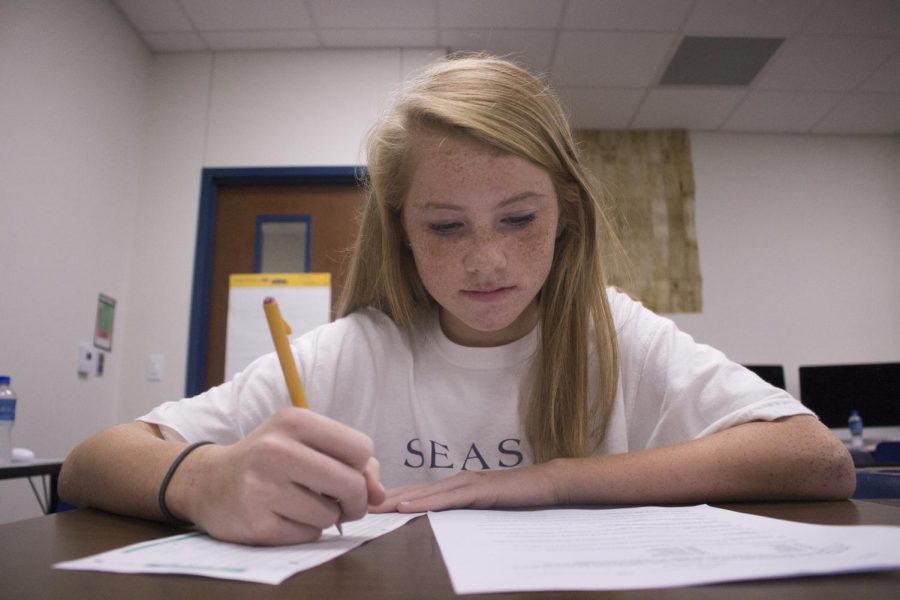Check out the cover story of our second issue of The Bagpipe magazine, written by freshman Kimmie Johansen.
***
There is a teacher shortage in public schools, and it is projected to get worse.
The gap between teacher demand and teacher supply was around 20,000 in 2012 and has more than quadrupled since then, according to the Economic Policy Institute. Because the student population is estimated to increase by three million students in the next decade, teacher demand is sharply rising. However, teachers are becoming more inclined to leave their jobs, and while there are multiple factors, there is one culprit overwhelmingly contributing to teacher dissatisfaction.
In 2013, Ron Maggiano resigned from West Springfield High School in Fairfax County, Virginia after a 33-year career as an educator. In a social media post, Maggiano explained his decision.
“I can no longer cooperate with a testing regime that I believe is suffocating creativity and innovation in the classroom,” Maggiano wrote. “We are not really educating our students anymore. We are merely teaching them to pass a test. This is wrong. Period.”
Maggiano is not alone. Forty-five percent of teachers considered leaving their profession due to standardized testing, according to a study done by the National Education Association. These teachers feel pressured to improve test scores but find “teaching to the test” has a negative impact on their classrooms.
Teachers here also side with Maggiano’s stance that standardized testing stifles their ability to teach their students ingeniously.
“I think standardized testing has taken creativity out of the classroom and is placing the teacher in some sort of a box where we have a list to check off in order for the students to be successful,” English teacher Lisa Seaman said.
Because teachers have to ensure they teach the material on the test, they are limited in their ability to engage students with activities stimulating high levels of learning. It also puts time constraints on teachers due to the fact that someone else is in charge of the curriculum that will assess their students.
“We are limited on the amount of time we can spend on one thing before we have to quickly move on to something else,” Seaman said.
The concept of mass standardized testing has been around since the Elementary and Secondary Education Act of 1965, which provided federal funding to districts serving low-income students and to state educational agencies in an effort to improve the quality of elementary and secondary education.
However, it was former President George W. Bush’s 2002 signing of the No Child Left Behind Act that brought on the current wave of standardized testing. It required students to be tested in reading and math annually during grades 3-8 and once in high school. It also mandated student testing in science once each in elementary, middle and high school. In 2015, former President Barack Obama signed the Every Child Succeeds Act into law to replace the No Child Left Behind Act, but it still requires the same amount of testing.
The purpose of these acts was to ensure every child learned the required curriculum and to hold schools accountable if they were consistently producing below average test scores.
In Texas, students take the State of Texas Assessments of Academic Readiness each spring, beginning in third grade with math and reading.
Former third-grade teacher at Hyer Elementary School Kristi Kellum taught for 17 years before accepting a non-teaching job in Allen ISD. In her tenure as a teacher, she prepared her students for their first STAAR test and felt constrained by the state’s standards.
“Our students have never seen a test like the STAAR, so as a third-grade teacher, we have to teach the content and teach our students how to take the test,” she said.
The immense stress to lead their students to strong test scores can be too much for some teachers.
“There’s pressure on us as teachers at a state level because each school is essentially graded based on their student’s test scores,” Kellum said. “Teachers often opt out of teaching grades that take the STAAR test because they are burned out from the pressure put on by the state.”
Today, STAAR tests are intended to measure both the proficiency of students in a particular subject, as well as a school’s overall ability to teach. Each year, the Texas Education Agency uses the results from to give schools an accountability rating.
The Texas Education Agency recently changed the state’s school rating system. In the past, the state would either mark a school as pass or fail. But in 2018, they dolled out letter grades to every school district, and for the first time this year, each school also received their own grade.
The state grades each district and school in three categories – student achievement on state tests, growth in student achievement on those tests and how disadvantaged students perform on those tests. The better score between student achievement and school progress counts for 70 percent of the overall grade, and closing the gaps between advantaged and disadvantaged students accounts for the remaining 30 percent.
The state forces schools earning a D or F to comply with improvement programs, which place additional administrative burdens on the already under-performing schools. They must go through additional diagnostics, adopt and implement corrective plans, attend hearings and submit scheduled progress reports. Furthermore, schools who consistently under perform on these tests for four years risk being shut down or having their district school boards taken over by the state.
Given the fact this new accountability system and its steep consequences for under performing all hinge on standardized test scores, it is clear the pressure teachers reportedly feel from testing is legitimate.
Fortunately for Highland Park High School, the district consistently earns As in the Accountability Rating system, except for one B in school progress, which measures academic growth from the previous year.
However, it is important to note that while the school earns an A in closing the gaps, there are 0 percent of students labeled as economically disadvantaged, 11.9 percent labeled at-risk and 0.6 percent labeled as English language learners, according to The Texas Tribune. Meanwhile, less than 5 miles down the road at Dallas ISD’s Thomas Jefferson High School, 77.7 percent of students are labeled as economically disadvantaged, 79.1 percent at-risk and 60.4 percent labeled as English language learners. Yet, Thomas Jefferson High School received a C in closing the gaps. But the hard truth the state’s standardized-test based accountability system fails to take into account is this: in a school like Thomas Jefferson, there’s simply more gaps to close.
Lovejoy ISD, which like Highland Park, is a small, one-high-school district in an affluent area, received the same scores from the state. And similar to Highland Park, Lovejoy High School educates 1.9 percent of students labeled economically disadvantaged, 6 percent of at-risk students and 0.5 percent English language learners.
Still, Thomas Jefferson’s C-score for closing the gaps stands in between a D in student achievement and a B in school progress. This isn’t unusual either. In 2018, districts with higher rates of economically disadvantaged or low-income students than the state average, accounted for the majority of schools with Ds and Fs, according to The Texas Tribune.
One reason schools heavily populated with lower-income students statistically seem to score lower is schools in these areas are under resourced, have higher student-to-teacher ratios and lack tutoring services. So, to then assign under performing schools with extensive administrative burdens, ends up draining the time, emotional and financial resources from the very schools where resources are the tightest.
Another disadvantage of this accountability system that schools face is the test merely represents one day of an entire school year.
“It’s unfair that one test on one day impacts how a school is rated when in reality one test is just a snapshot into a school,” geometry teacher Staci Kimbrough said.
The tests do not take into account the limitless possibilities of negative influences on a student the day of the test either.
“There are so many factors that go into how a student will perform on an assessment on any given day that go beyond how well a student understands the content they’ve learned,” she said.
For example, students could be sick or experiencing loss of a family member. They may not have slept or ate breakfast. None of this is measured on the test,
Aside from the inaccurate representation of a school based on one test, another pitfall is these tests are not even necessarily an accurate measure of student learning. These tests measure student learning using multiple-choice style questions.
The problem is anyone can make a guess and get the right answer without understanding the concept, which explains why these tests are often referred to as “multiple-guess.” Plus with the correct answer just one of four options laid out right in front of the student, this format constrains critical thinking.
“Just asking you to recall a bunch of things is not enough to prove high levels of learning,” Principal Walter Kelly said. “I’m hoping what we think of to be a standardized test becomes more of a performance assessment.”
Kelly, who also serves as an advisory board member of the Harvard Graduate School of Education’s Principals’ Center, explains a performance assessment as solving problems that don’t have an easy answer. For example, students could develop a project that does certain things.
“Finding ways to really measure that would be a much more meaningful way to measure what students know,” he said.




